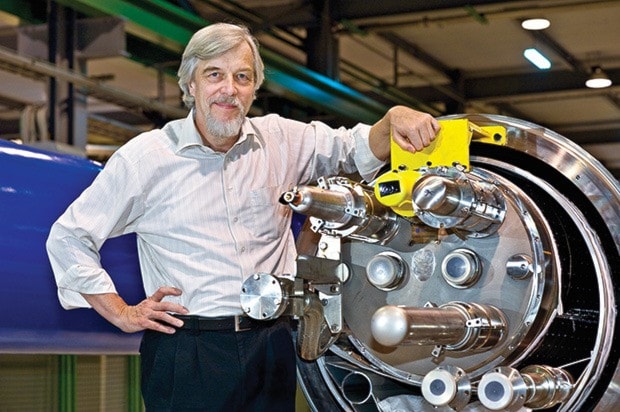The mystery of dark matter longs to be solved, and while many a physicist tackles the cause, one will come to UVIc to talk about it.
Scientists say the Higgs boson, or “God particle”, may only be the first of many such discoveries to be made in the Large Hadron Collider (LHC) at the CERN facility in Geneva, Switzerland. On Monday, Dr. Rolf Heuer, director general of CERN, will talk about the recent relaunch of the LHC, the significance of the Higgs boson, and what we can expect from the LHC in the coming months.
The inaugural Alan Astbury memorial public lecture honours the late professor with Nobel connections.
“Alan was a very famous physicist and known all over the world,” said Dr. Richard Keeler, a longtime colleague of Astbury.
Keeler worked with Astbury from 1981 (two years prior to either of them being employed at UVic) until Astbury’s death last year.
“I went to CERN as a young post-doctoral fellow in 1980 and worked in Alan’s group … That experiment got the Nobel Prize so that made us popular,” Keeler said.
The Nobel Prize in Physics for 1984 was awarded jointly to Carlo Rubbia and Simon van der Meer for decisive contributions to the large project, a collaborative effort of many people that led to the discovery of the field particles W and Z.
“He was a really big part of the second Nobel Prize that the Higgs experiment got,” added Keeler.
Astbury was director of TRIUMF laboratory in Vancouver from 1994 through 2001. He strengthened TRIUMF’s reputation as a prime institution for subatomic research and redefined the priorities of its program. The widely recognized scientist furthered Canadian participation in international particle physics projects by arranging Canada’s contribution to the LHC.
“This will be the first in a series of lectures. We’ll see where it takes us,” said Keeler.
It’s a fitting tribute for the first memorial lecture, as Heuer will talk about seeing where the LHC accelerator can take them next.
“It has an accelerator which is circular and is 27 kilometres in circumference. It’s the world’s largest machine of any kind and it’s the world’s largest particle accelerator,” Keeler explained. “It collides protons with protons head on, and then we analyze what comes out of these collisions.”
Already credited with the discovery of the Higgs boson, widely known as the God particle, the LHC holds the key to discovering the origin of mass, the nature of dark matter and more.
“The accelerator’s been shut down for almost two years and it’s been through a major service call. It’s now going to be raised to a higher energy,” Keller said, adding it should produce nearly twice as much energy. “That means maybe we can produce new stuff. Nobody’s seen collisions like these in a laboratory before. There are things we’re looking for and that’s where our astrophysical friends with telescopes come in.”
Those “friends” have noticed more unusual material in the universe.
“There’s four to five times more of this dark matter than the stuff we’re made out of. It’s actually the dominant stuff in the universe and we’re at the lower end. But we’ve never been able to see it in the lab,” Keeler said. “We’d like to make that at the collider, that’s one of the things we’re looking for.”
The lecture takes place Monday at 7:30 p.m. in the Bob Wright Centre, room B150. A live webcast will also be available via www.uvic.ca/astbury.
